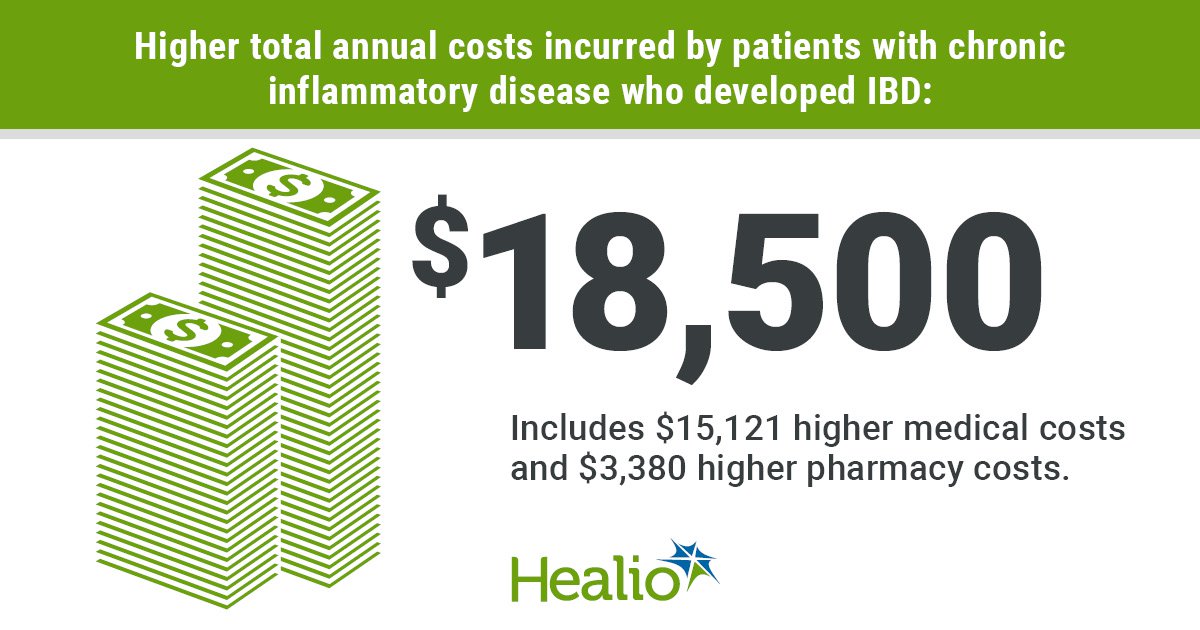Concomitant inflammatory disease, IBD linked to higher health care use, costs

Patients with both chronic inflammatory disease and inflammatory bowel disease demonstrated higher health use and costs, compared with those with just chronic inflammatory disease, according to data published in BMC Rheumatology.
“While multiple previous studies have assessed the incremental burden of IBD relative to controls without IBD, little is known on the burden of IBD in patients with pre-existing [chronic inflammatory disease],” David Hudesman, MD, of the New York University School of Medicine, and colleagues wrote.
“A recent real-world analysis of the economic burden associated with IBD among patients with psoriatic arthritis and ankylosing spondylitis in the United States showed that compared to patients without IBD, those with IBD had significantly higher total health care costs — up to 27% higher in patients with PsA and 38% higher among patients with AS,” they added. “However, this analysis exclusively focused on patients with PsA or AS; thus, it is unclear whether the conclusions of this study can be generalized to other patients with [chronic inflammatory disease].”
To analyze the incidence of IBD, as well as health care use and costs linked to IBD, among patients with chronic inflammatory disease, Hudesman and colleagues conducted a retrospective longitudinal cohort study using the IBM MarketScan Research Databases from Jan. 1, 2010, to July 31, 2017. The databases included claims from approximately 75 million individuals covered through 100 payers.

Using these data, the researchers identified 537,540 patients with at least two claims with a diagnosis of either AS, PsA, psoriasis or rheumatoid arthritis. Hudesman and colleagues then calculated the 1-year incidence rate of IBD following the index date. They compared health care use and costs between patients who developed IBD and those who did not in the year after the index date, adjusting for baseline characteristics.
Results showed the 1-year incidence rate of IBD overall was 0.52%, ranging from0.39% among patients with psoriasis but without PsA to 1.73% in those with AS. The2,778 patients who developed IBD demonstrated significantly higher rates of inpatient, outpatient and emergency department visits (IRR =2.91; P<.0001), compared with patients without IBD. Further, patients who developed IBD incurred $18,500 (P<.0001) higher total costs each year, including $15,121 (P<.0001) higher medical costs and $3,380 higher pharmacy costs (P<.0001).
“There is an increased incidence of IBD among patients with chronic inflammatory disorders, such as PsA, RA and AS, which leads to higher health care costs and utilization.,” Hudesman told Healio Rheumatology. “It is important for physicians to have a low threshold to refer to a gastroenterologist to evaluate for IBD, so that when managing these patients, the correct medication is chosen that will treat both the IBD and the rheumatologic disease.” – by Jason Laday
Disclosures: Hudesman reports consulting fees from Janssen, Takeda, AbbVie and Salix, as well as consulting fees and research support from Pfizer. Please see the study for all other authors’ relevant financial disclosures.
